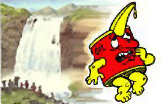Who said water and oil don’t mix?
by Fritz Guenther #22T
In a previous article “The Great Synthetic Oil Myth” we discussed the benefits of synthetic oils; low temperature performance, high temperature viscosity stability and oxidation resistance to name a few. In my opinion, one of the greatest benefits synthetic oil has over its mineral based brethren never comes up in the oil debate wars. So here we go.
 Synthetic oils have the ability to hold twice the amount of dissolved water that mineral based oils do. Synthetic oils have the ability to hold twice the amount of dissolved water that mineral based oils do.
To fully understand where I’m going with this we first need to agree on several things:
Water, along with atmospheric dirt, combustion by products and wear metals, are the leading culprits contributing to oil contamination. Even if you don’t ride your bike through mud, streams, subject it to a 2800 psi pressure washer or ride in the rain you’ll end up with some amount of water in your oil from condensation caused by normal temperature changes.
4 strokes are especially prone to water contamination due to the fact that, depending on the direction of piston travel are either moving air in or out through the crankcase vent. To get an idea how much volume these bikes actually move in and out of the crankcase, take a look at the size of the breather hose on a 4 stroke compared to a 2 stroke.
Now that we (hopefully) agree we can and do get water contamination in our oil let’s take a look at how this affects our engines. Water in our lubricant of choice can exist in 3 different forms.
DISSOLVED WATER: water in this phase is on the molecular level which means it is too small to detect visually or in other words to small to do any real harm. If the moisture content continues to increase, at some point our oil will reach its saturation point. This is where we move to the next phase.
EMULSIFIED WATER: Emulsified water in oil is characterized by very small (microscopic) droplets that start to give the oil a cloudy appearance. If the amount of moisture continues to increase the oil will then take on a milky appearance. Once we have reached this point the addition of any more moisture will cause a separation of the water and oil which brings us to the last and most harmful phase.
FREE WATER: A definitive layer of clear water with the emulsified water being present as well characterizes free water. In lubricants with a specific gravity of less than 1.0 the free water will be on the bottom.
Most of the negative effects of water in our lubricant is widely known by all and characterized by the most visible consequence, oxidation or rust. Rust and oxidation particles are extremely hard and when circulated through our engines do nothing but bad things. This can best be described as “acute” wear. If you are running your bike with free or emulsified water in your lubricant you are carving the life and reliability out of your engine at an alarming rate. Keep this up and you’ll be walking in no time, not to mention the “acute” effect this is going to have on your wallet.
Some of the more “chronic” or long term problems free and emulsified water cause occurs in bearings. Journal or plain bearings operate on the hydrodynamic fluid film property, the incompressibility of water results in the loss of a critical fluid film that separates the 2 moving parts. The result of which is accelerated bearing wear. 1% water contamination in your lubricant can reduce journal bearing life by 80%.
Gears and anti-friction (rolling element bearings as they are commonly referred to today) operate on elastohydrodynamic or EHD lubrication. As the rolling elements of a bearing or the pitch line of a gear pass through the load zone momentary pressures can go as high as 500,000 psi (no it’s not a typo) as these pressures increase so does the viscosity of the lubricant to the point where it actually becomes a solid. Water, conversely experiences a drop in viscosity as pressure increases resulting in a loss of EHD film. As the amount of water in your oil increases so does the possibility of metal on metal contact resulting in adhesive wear or spalling.
Another interesting failure mode in gears and bearings operating on EHD lubrication is hydrogen embrittlement or blistering caused by water contamination. This is a result of the water in a lubricant undergoing a molecular change under extreme pressure. The hydrogen atoms are separated out of the water molecule and forced into the bearing metal causing changes in the metallurgy. This resultant change or weakening in the bearing metallurgy increases the chances of cracking in the bearing races which leads to pitting and spalling.*
All of the above is a long-winded way of saying that water in your oil is a bad thing. I run synthetic oil in my bike not because I ride in sub zero temps (although I have and don’t recommend it) or blast through the desert southwest WFO on a 110 degree day, I use synthetic oil because I’m an occasional rider, a couple or 3 times a month on average. I want a lubricant that can hold twice the amount of dissolved water that mineral based oil can while my bike is sitting in the garage wondering when her next date is.
*Water-The Forgotten Contaminant, Mark Barnes Noria Corp.
***
|